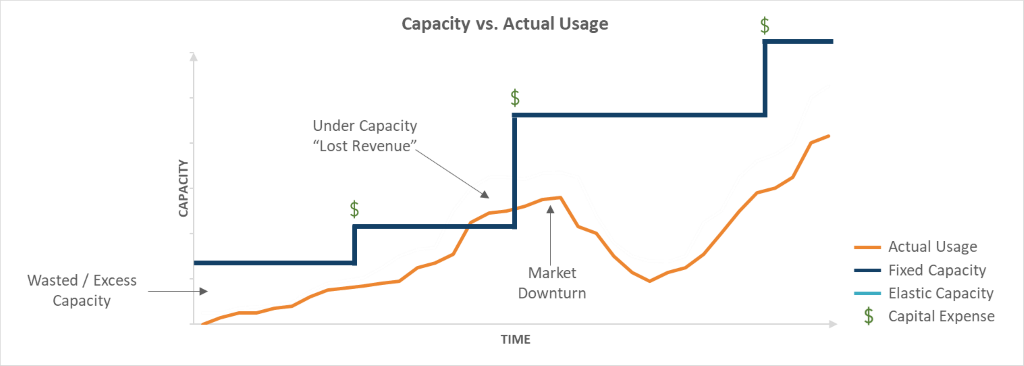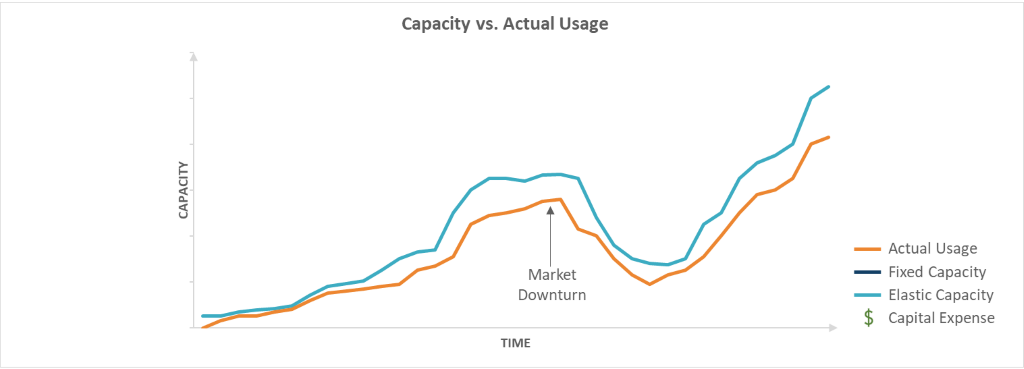One of the biggest challenges organizations experience when building and maintaining their own technology framework is planning how much infrastructure the business will need to run adequately now, and in the future. Traditionally, with data center hosting, planning requires estimating the highest peak needs, and buying to be ready for those peaks well before they occur. For example, consider an application platform built to handle 300 users now, but the company plans to grow by 100% to 600 users in the next three years. They would need to purchase the excess capacity now to handle the growth later. As a result, the company has less cash on hand and excess infrastructure in boxes outside its data center. Sure, this company has gained assets, which should provide value in the future, but what if that future does not go as planned? In today’s uncertain economic times, many businesses are paying the price because they did not anticipate what the impact of a global pandemic would be. What if organizations were able to only pay for the infrastructure needed, based on the usage required to keep their business afloat? Cloud service providers have built their platforms to help with this exact scenario. In this blog entry, we will walk through some ways that companies have leveraged the flexibility of the cloud to weather the storm and how other companies find themselves at a crossroads because their business may not be able to survive.
First, let’s get some terminology out of the way. When we refer to Cloud Service Providers, we are talking about companies like Amazon Web Services (AWS), Microsoft Azure, Google Cloud Platform (GCP) and others who have built a business around providing scalable and flexible infrastructure and services for their customers by leveraging their own resource pools. While Cloud Service Providers offer many services to help companies be more nimble and innovative, our focus is on Infrastructure as a Service (IaaS) – traditional data center hosted hardware, whether virtualized or not. An infrastructure purchase is usually significant and will impact the bottom line of any business.
The chart below details what happens when a company staggers its purchase capacity for expected growth (much like the example mentioned earlier), aligned with an economic downturn similar to what we are experiencing now.

Notice there are a few factors at play in this chart:
- Three purchasing events that increased capacity which may have come with new product launches, marketing campaigns, headcount growth, etc.
- Excess capacity which means money spent, but underused.
- A period of under capacity which may have been a period of downtime, lost customers and / or lost revenue.
This chart depicts the historical model for companies that host their organization’s infrastructure in data centers; generally, managing a plan and hoping for the best based on past experiences. This is an optimistic usage curve for our example IT organization because, in reality, there is not always an uptick on the backend of the market downturn.
What this organization needs is a cloud capacity strategy that works with the ebbs and flows of the business and the market. If the company decided to go to a cloud-based strategy rather than hosting their own infrastructure, they would find themselves with the capacity and usage chart similar to the one below:

Looking at the spread between the actual usage and the capacity of leveraging the cloud service provider shows there is minimal capacity waste and the capacity follows the actual usage of the business. Of course, there is no perfect scenario and, in most cases, the chart is not going to flow exactly to the trend. However, this provides an illustration of what is possible by leveraging a cloud provider and configuring the environment to be flexible with the business needs. This is known as leveraging the elasticity of the cloud.
One caveat that must be considered is that these charts assume the market comes back for this business. With the cloud model, the lines would still be nearly converging, but in the data center model, cash has already been spent and new cost cutting measures would need to be invoked.
Other Infrastructure Capacity Impacts
While most of the earlier examples focus on the organization’s entire infrastructure capacity, it is also important to consider other ways that the flexibility of the cloud will help businesses during economic downturns. For example, let’s look at a food service provider in the current market who relies heavily on an innovative platform for providing services to its customers. At this point, this business simply wants to ensure it can stay in business and not add innovative features to its platform. The flexibility of the cloud will allow this provider to minimize or remove its development, test and disaster recovery infrastructure, leading to immediate cost savings.
On the flip side, consider a pharmaceutical company working around the clock to find a cure to this global pandemic. Using cloud technologies, this company is able to ramp up its efforts with more computing power to test models more quickly, as it works to push forward with a solution in record time. When that solution is discovered, this company can transition the money spent on infrastructure to producing that solution, leveraging other hardware or manufacturing while at the same time dropping its cloud spend.
Conclusion
The cloud allows an organization to be agile in uncertain times in a way that data center hosted infrastructure does not allow. Current market conditions should encourage everyone to think about the systems and infrastructure they are now using to determine if those platforms can provide agility and respond to rapid market fluctuations like we have seen in the past few months. Every organization should review their workloads and develop a cloud strategy to migrate systems to gain the agility the business needs to thrive in uncertainty.
Want to learn more about our Cloud solutions and how we help organizations migrate to the cloud? Contact us.
Webinar: Finding Cloud Cost Savings, today (April 28) @ 12 pm EDT or view on demand.



